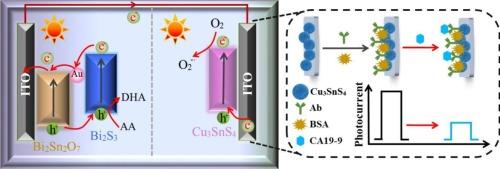双光电极协同信号放大集成自供电光电化学免疫传感器灵敏检测CA19-9
IF 4.1
3区 化学
Q1 CHEMISTRY, ANALYTICAL
引用次数: 0
摘要
传统的光电阳极光电电化学(PEC)传感系统抗干扰能力较弱,而光电阴极传感系统的信号响应往往较弱。为了解决这一矛盾,开发了一种集成Bi2Sn2O7/Au/Bi2S3光阳极和Cu3SnS4光电阴极的双光电极内驱动自供电PEC传感系统,用于准确灵敏地检测碳水化合物抗原19-9 (CA19-9)。Bi2Sn2O7/Au/Bi2S3三元异质结作为光阳极可以有效增强PEC信号,Cu3SnS4光电阴极作为工作电极可以很好地提高PEC传感系统的抗干扰性。利用双光电极协同效应,该生物传感平台具有良好的CA19-9检测性能,线性范围为0.0001 ~ 100 U mL - 1,检出限为2.87 × 10 - 5 U mL - 1 (S/N = 3)。所构建的自供电PEC平台具有高灵敏度、良好的稳定性和选择性,为疾病相关生物标志物的分析提供了一种高效、简便、通用的方法。本文章由计算机程序翻译,如有差异,请以英文原文为准。

Dual-photoelectrode synergistic signal amplification-integrated self-powered photoelectrochemical immunosensor for sensitive CA19-9 detection
Traditional photoanode-based photoelectrochemical (PEC) sensing systems suffer from weak anti-interference ability, while photocathode-based systems always show weak signal response. To resolve this contradiction, a dual-photoelectrode internally driven self-powered PEC sensing system integrating Bi2Sn2O7/Au/Bi2S3 photoanode with Cu3SnS4 photocathode was developed for the accurate and sensitive detection of carbohydrate antigen 19-9 (CA19-9). The Bi2Sn2O7/Au/Bi2S3 ternary heterojunction as photoanode efficiently enhance PEC signal, while Cu3SnS4 photocathode acted as working electrode could well improve the anti-interference of PEC sensing system. Benefit from the dual-photoelectrode synergistic effects, the proposed biosensing platform exhibited a fine performance for CA19-9 detection with a linear range of 0.0001 U mL−1 to 100 U mL−1 and a detection limit of 2.87 × 10−5 U mL−1 (S/N = 3). The constructed self-powered PEC platform with the merits of high sensitivity, satisfactory stability and selectivity, provides an efficient, facile, and general method for disease-related biomarkers analysis.
求助全文
通过发布文献求助,成功后即可免费获取论文全文。
去求助
来源期刊
CiteScore
7.80
自引率
6.70%
发文量
912
审稿时长
2.4 months
期刊介绍:
The Journal of Electroanalytical Chemistry is the foremost international journal devoted to the interdisciplinary subject of electrochemistry in all its aspects, theoretical as well as applied.
Electrochemistry is a wide ranging area that is in a state of continuous evolution. Rather than compiling a long list of topics covered by the Journal, the editors would like to draw particular attention to the key issues of novelty, topicality and quality. Papers should present new and interesting electrochemical science in a way that is accessible to the reader. The presentation and discussion should be at a level that is consistent with the international status of the Journal. Reports describing the application of well-established techniques to problems that are essentially technical will not be accepted. Similarly, papers that report observations but fail to provide adequate interpretation will be rejected by the Editors. Papers dealing with technical electrochemistry should be submitted to other specialist journals unless the authors can show that their work provides substantially new insights into electrochemical processes.

 求助内容:
求助内容: 应助结果提醒方式:
应助结果提醒方式:


